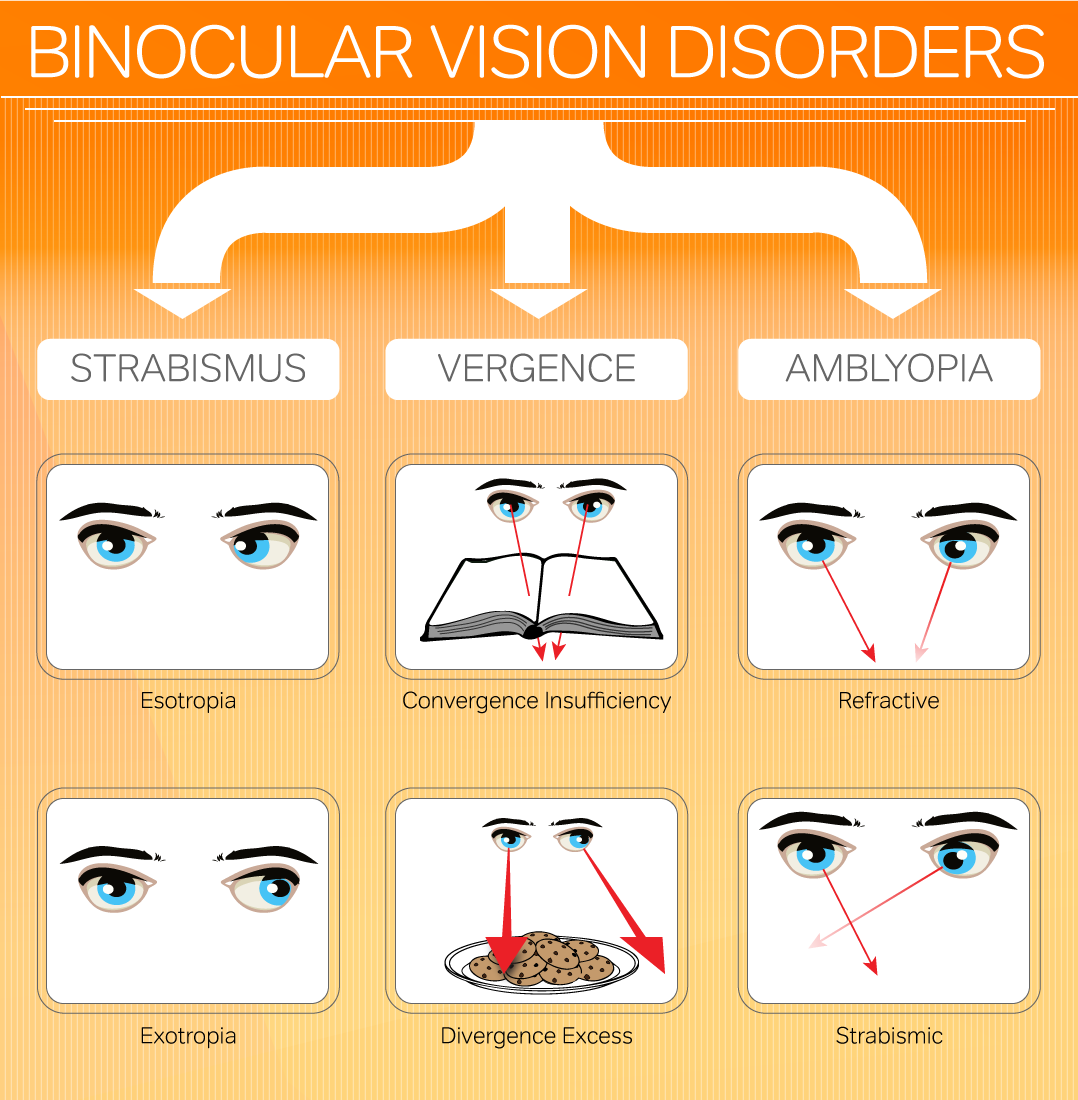Signs and Symptoms of Binocular Vision Problems
Many binocular vision disorders cause patients so suffer from similar symptoms. First, keep in mind that signs and symptoms are abnormalities that can indicate a potential problem, so it's always a good idea to get an evaluation by a licensed medical professional (optometrist, ophthalmologist) if you experience any of these. Signs are objective - that means it can be seen, evaluated, or tested (for example a visible eye turn). Symptoms are subjective, meaning experienced or apparent only to the patient (for example eye pain, tired eyes, etc.).
The graphic below illustrates some common binocular vision disorders encountered in an eye clinic (this is by no means an exhaustive list).

Strabismus
Esotropia - (eye turns in) or a constant inward deviation of the eye. Esotropia is where one eye looks directly at the object being viewed and the other is misaligned inward toward the nose. This is commonly referred to as crossed eyes or cross-eyed.
Exotropia - (eye turns out) or a constant outward deviation of the eye. Exotropia is where one eye looks directly at the object being viewed and the other is misaligned outward away from the nose. This is also called wall-eyed.
Vergence
Convergence Insufficiency - The eyes are unable to maintain convergence at near for an extended period of time (reading a book for example). These patients may intermittently lose fusion which causes double vision and other symptoms mentioned here.
Divergence Excess - is an over-divergence when attempting to look at distant objects.
Amblyopia
Refractive - also known as anisometropic amblyopia. This occurs when there is a high degree of nearsightedness or farsightedness in one or both eyes
Strabismic - is caused by a misalignment of the eyes. The weak eye is often suppressed to prevent double vision or diplopia.
When the two eyes do not function together appropriately, a patient can present with eye issues through a variety of symptoms and signs. Symptoms of a Binocular vision dysfunction may include (but is not limited to):
- Blurry vision
- Eye strain
- Difficulty driving
- Headaches
- Suppression
- Double vision
- Tiredness with near work
- Car sickness or motion sickness
- Dizziness
- Reading difficulties (reading words themselves or remembering/retaining information that was read)
- Light sensitivity
Signs and Symptoms
Signs of a binocular vision disorder are more obvious (and maybe concerning if they are brand new!)
- Visible eye turn (strabismus)
- Inability to move one or both eyes in one or more direction(s)
As you can see, the list of SIGNS easily observed that suggests a disorder of binocular vision is far less than SYMPTOMS. To further complicate the symptom/sign discussion, conditions like a history of a head or traumatic brain injury may exacerbate these symptoms.
If you are experiencing any of these eye strain symptoms and/or depth perception problems we recommend visiting your private optometrist or ophthalmologist.
The Vision Wiki
- Binocular Vision
- Vision Tests
- Suppression Tests
- Worth 4 Dot
- Tests of Stereopsis
- Cover Test
- Definitions
- Signs and Symptoms
- Blurry Vision
- Reading Problems
- Eye Strain
- Driving Problems
- Headaches
- Suppression
- Double Vision
- Motion Sickness and Car Sickness
- Pias Vision
- Visual Skills
- Visual Tracking
- Visual Fixation
- Stereopsis
- Depth Perception
- Visual Accommodation
- Visual Requirements for Baseball
- Visual Requirements for Pilots
- Reading
- Foundational Reading Skills
- Vision and Learning
- Fusion
- Convergence and Divergence
- Reading Skills
- Visual Processing
- Eye Problems
- Physiology of Vision
- Lazy Eye
- Lazy Eye Treatments
- Reading
- Fields of Study
- Research
- Glaucoma
- Virtual Reality
- Organizations
